ARRIVE DELHI
Arrive this evening by flight. After clearing immigration and custom formalities, you will be required to collect your bags from the baggage belt and proceed to the arrival lounge. Your representative will be waiting there and will transfer you to your hotel.
DELHI
There have been at least eight cities built over the millennia around modern New Delhi, the capital of India. Standing on the west bank of the Yamuna river at the narrowest point between the Aravallis hills and the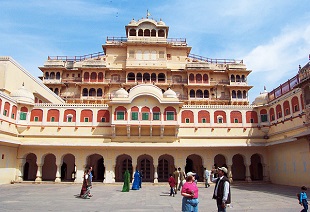 Himalayas, for over 2,000 years Delhi has commanded the strategically vital route from the Northwest frontier to the agriculturally rich Ganga plains. Former Sultans have left their lasting mark in the Qutab Minar complex, while Old Delhi, Emperor Shah Jahan’s 17th century capital, retains a flavors of its atmospheric past.
Himalayas, for over 2,000 years Delhi has commanded the strategically vital route from the Northwest frontier to the agriculturally rich Ganga plains. Former Sultans have left their lasting mark in the Qutab Minar complex, while Old Delhi, Emperor Shah Jahan’s 17th century capital, retains a flavors of its atmospheric past.
Overnight at the hotel.
DELHI - UDAIPUR
After breakfast at the hotel, a representative will transfer you to the airport in time to board your flight departing for Udaipur
A representative will meet you upon arrival at Udaipur & transfer you to your hotel, where you will proceed for check in.
UDAIPUR
Set amidst the Aravallis hills of south Rajasthan, Udaipur (City of Sunrise) is a beautiful city regarded as one of the most romantic in India. Presenting an enchanting image of marble palaces, placid lakes, attractive gardens and green hills, it has been called “the Venice of the East”. It was founded by Maharana Udai Singh II in 1568 as a traditionally planned, fortified city full of palaces, temples and Havelis. The city also became a centre for the performing arts, painting and crafts
Overnight at the hotel.
UDAIPUR
Breakfast at Hotel.
Begin your half-day sightseeing tour of Udaipur with City Palace and Museum. The largest palace complex in India, it is a blend of Mughal and Rajput influences. Also see the 17th century 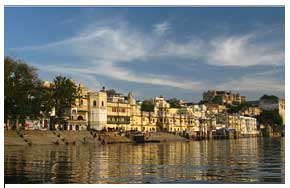 Jagdish temple, drive around the Fatehsagar Lake, and visit the Sahelion ki Bari (the Garden for the Maids of Honor), an ornamental pleasure garden with fountains and marble kiosks.
Jagdish temple, drive around the Fatehsagar Lake, and visit the Sahelion ki Bari (the Garden for the Maids of Honor), an ornamental pleasure garden with fountains and marble kiosks.
Late in the afternoon proceed for boat ride in Lake Pichola.
Overnight at the hotel
UDAIPUR - JODHPUR
Breakfast at Hotel.
Later drive to Jodhpur en-route visiting Ranakpur.
RANAKPUR
Ranakpur, about 90 km from Udaipur, is the largest Jain temple complex in India and dates to the 15th century. The main temple is dedicated to Adinath, the first Tirthankars. Intricate carvings detail mythological figures, patterns and motifs on the walls, pillars and domes there are 1444 ornately carved marble pillars in the complex and none of them are similar. The beautiful lace-like interiors of the domes are a superb example of western Indian temple style. Surya temple and other Jain temples are side attractions. (Temples open only at 1200 Hrs. Leather belts, footwear, bare legs and black clothing not allowed)
Continue drive to Jodhpur. Arrive Jodhpur and proceed for check in.
JODHPUR
Jodhpur, the second largest city in Rajasthan, lies at the entrance to the Thar Desert in a region called Marwar. A 10 km long wall surrounds the old city, founded in 1459. The massive Mehrangarh Fort overlooks the city and the red sandstone palaces within the fort form one of the most impressive complexes in Rajasthan. Jodhpur is also called ‘blue city’ because of the indigo-washed houses in the old town.
Overnight at the hotel
JODHPUR - JAISALMER
Breakfast at the hotel.
Morning half-day city tour visit the Mehrangarh Fort, situated on a low sandstone hill. The palace apartments like Sukh Mahal, Phool Mahal, Sheesh Mahal etc are beautifully decorated and house jewellery, costumes, armory, palanquins, howdahs and other remnants of the past.
See the Jaswant Thada, an imposing marble memorial to Maharaja Jaswant Singh II built in 1899.Later the royal crematorium and three other cenotaphs were also built here. Also visit the museum located in the Umaid Bhawan Palace.
After sightseeing tour continue your drive to Jaisalmer - The approach to JAISALMER across the arid Thar Desert is truly magical as the city shimmers like a mirage. With the crenulated golden sandstone town walls and narrow streets lined with exquisitely carved buildings, it has an extraordinary medieval feel.
On arrival check-in at the hotel. Overnight at the hotel.
JAISALMER
Breakfast at the hotel.
Throbbing in the heart of the Thar Desert, Jaisalmer is an intricately moulded wonderland. Take a half-day sightseeing tour of this city of gilded magic. See the fort built by Rawal Jaisal atop the 80 m high Trikuta hill, where a fourth of the population still lives. Within the fort are also beautifully carved Jain temples of the 12th to the 15th centuries. See Badal Vilas Palace, the former ruler’s 20th century palace. Also visit some impressive merchant mansions (Havelis) including Patwon ki Haveli (1805), a five-storey building with carved pillars and murals, Salim Singh and Nathmalji ki Havelis.
80 m high Trikuta hill, where a fourth of the population still lives. Within the fort are also beautifully carved Jain temples of the 12th to the 15th centuries. See Badal Vilas Palace, the former ruler’s 20th century palace. Also visit some impressive merchant mansions (Havelis) including Patwon ki Haveli (1805), a five-storey building with carved pillars and murals, Salim Singh and Nathmalji ki Havelis.
Late in the evening - Visit the Sam sand dunes and have a camel ride to view the sunset.
Return to Jaisalmer. Overnight at the hotel.
JAISALMER – BIKANER
After breakfast at the hotel drive to Bikaner.
BIKANER – It is a desert town surrounded by a high crenulated wall, which was once an important staging post on the great caravan routes. Later visit Junagarh Fort and camel breeding farm. (Camel Breeding Farm remains closed on Sundays)
Overnight at the hotel.
BIKANER – JAIPUR
Breakfast at Hotel.
After breakfast depart for Jaipur by road. Upon arrival in Jaipur check-in at the hotel
JAIPUR has been called the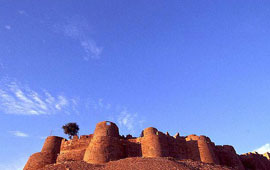 Pink City ever since Maharaja Sawai Jai Singh II had built it in 1727. It is the only city in the world symbolizing the nine divisions of the Universe through nine rectangular sectors sub-dividing it. The architect who formalized the city’s plans on the Shilpa Shastra, the epic Hindu treatise on architecture, mixed it with the sublimity of the Mughal and Jain influences of those times. Except for the busy traffic of bicycles, cars and buses, little seems to have changed.
Pink City ever since Maharaja Sawai Jai Singh II had built it in 1727. It is the only city in the world symbolizing the nine divisions of the Universe through nine rectangular sectors sub-dividing it. The architect who formalized the city’s plans on the Shilpa Shastra, the epic Hindu treatise on architecture, mixed it with the sublimity of the Mughal and Jain influences of those times. Except for the busy traffic of bicycles, cars and buses, little seems to have changed.
Overnight at the hotel.
JAIPUR
Breakfast at hotel.
Morning visit Amber Fort - the ancient capital of the State until 1728. Visit the Jagmandir or the Hall of Victory glittering with mirrors, Jai Mahal and Temple of Kali. Drive up the hill on Jeeps on which the Fort is situated. The main attractions are the Sukh Mandir (Temple of Contentment – an aptly named pleasure chamber, cooled by a stunning water cascade) and the Sheesh Mahal (Mirror palace).
Photo stop at Hawa Mahal (Palace of the Winds). Take a half-day tour of the city visiting the Maharaja’s City Palace and the Jantar Mantar Observatory. Jaipur’s walled City Palace (1732 AD) occupies one-seventh of the city’s area. See the Mubarak Mahal, museums of textiles and armory etc, and the Diwan I Khas and Diwan I Am. Jantar Mantar, literally meaning “instruments for measuring the harmony of the heavens” is the oldest in India. Each instrument has a specific purpose and gives an accurate reading.
Overnight at the hotel.
JAIPUR – FATEHPUR SIKRI - AGRA
Breakfast at Hotel.
Later depart for Agra, enroute visiting Fateh Pur Sikri. (260Kms, 6 Hours Drive)
FATEH PUR SIKRI
Though Emperor Akbar had many wives, he had no children. He visited a holy man Sheikh Salim Chisti at Sikri. The holy man told the emperor that he would have three sons. Soon the prophecy was fulfilled. He was so impressed by this sequence of events and decided to build a city at Sikri to honor the saint. The construction started in 1569 was the Old capital of the Mughal, which was abandoned after 15 years due to scarcity of water. See the graceful buildings including the Jama Masjid, Tomb of Salim Chisti, Panch Mahal and other Palaces.
Continue drive to Agra. On arrival check in at the hotel
Overnight at the hotel.
AGRA – DELHI
Breakfast at Hotel .Proceed for visit of Taj Mahal and Agra Fort.
AGRA
Agra lies to the southeast of Delhi and is home to the world-famous Taj Mahal. Agra rose to its fame in the medieval period as the capital of the Mughal Empire and it was beautified with gardens, waterfalls, bathhouses and canals.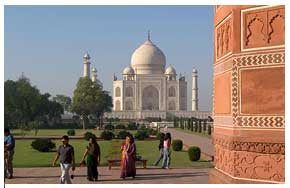 In the modern times, the city of Agra is a thriving carpet industry where you can also find leather workers; sandstone and marble sculptors, some of whom claim to be direct descendants of the craftsmen who had helped build the Taj Mahal.
In the modern times, the city of Agra is a thriving carpet industry where you can also find leather workers; sandstone and marble sculptors, some of whom claim to be direct descendants of the craftsmen who had helped build the Taj Mahal.
TAJ MAHAL - built by Mughal Emperor Shah Jahan in 1630 in memory of his beloved Queen Mumtaz Mahal, to enshrine her mortal remains. The monument has been described as the most extravagant ever built for love, the emperor was
heart broken when the Mumtaz, to whom he had been married for 17 years, died in 1627 in childbirth soon after delivering the 12th child.
Afternoon visit AGRA FORT built in 1565. There are many fascinating buildings inside the massive walls which stretch for 2½ km surrounded by a moat over 10 meters wide. The fort is really a city within a city, which embraces the Moti Masjid, the Diwan-i-Am or the Hall of Public Audiences, the Diwan-i-Khas or the Hall of Private Audiences, the Octagonal Tower, Jehangir’s Palace and many more monuments.
Late evening transfer to Delhi by road
LEAVE DELHI
After buffet breakfast at the hotel, you will proceed for a full day city tour of Old & New Delhi.
You will first visit Old Delhi. The tour will begin with a visit to Raj Ghat, a simple memorial to Mahatma Gandhi; drive past the Red Fort continuing to the Jama Masjid by bicycle rickshaws,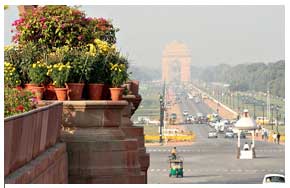 one of Asia’s largest mosques. The magnificent Red Fort, over looking the river Jamuna was built during the years 1638 - 48 when the Moghul Empire was at its peak. The tour continues to Jama Masjid, one of Asia’s largest mosques and which is viewed from the outside. People stream in and out of the mosque continuously and the presence of a nearby bazaar means that the area is rarely quiet.
one of Asia’s largest mosques. The magnificent Red Fort, over looking the river Jamuna was built during the years 1638 - 48 when the Moghul Empire was at its peak. The tour continues to Jama Masjid, one of Asia’s largest mosques and which is viewed from the outside. People stream in and out of the mosque continuously and the presence of a nearby bazaar means that the area is rarely quiet.
After visiting Old Delhi, you will be driven to New Delhi, which reflects the legacy the British left behind. The division between New and Old Delhi is the division between the capitals of the British and the Mughals respectively. The division in the walled city and New Delhi also marks the division in the life-styles. The walled city is all tradition where one will be able to glean a past life-style in all its facets, colours and spells. New Delhi in contrast, is a city trying to live up to the best of 21st century standards.
The tour to Imperial Delhi will include a visit to the Qutub Minar, the tallest stone tower in India. Qutub-ud-din Aibak started it in 1199. Pulling down 27 Hindu and Jain temples and using their columns erected the attached Quwwat-ul-Islam mosque also built by him. Then visit Humayun’s tomb, built by the widow of the second Mughal Emperor, Humayun, it is an outstanding monument in the Indo-Persian style, a precursor of the Taj Mahal. The tour also includes a drive past the imposing India Gate, the Parliament building and the Rastrapathi Bhawan, the President’s residence.
Evening transfer to airport